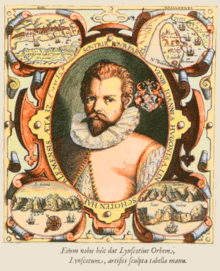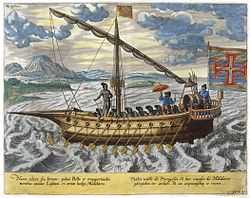Jan Huyghen van Linschoten

Jan Huyghen van Linschoten (1563 – 8 February 1611) was a Dutch Protestant merchant, traveller and historian. An alternative spelling of his second name is Huijgen.
He is credited with publishing important information about Asian trade, such as the navigational routes that enabled the passage to the elusive East Indies to be opened to the English and the Dutch. This enabled the British East India Company and the Dutch East India Company to break the 16th century monopoly enjoyed by the Portuguese on trade with the East Indies.
Origins
Jan Huyghen was born in Haarlem in the Netherlands, the son of a public notary, but the family moved to the town of Enkhuizen when he was young. The addition of van Linschoten could indicate that his family had origins in the Utrecht village of the same name .
Early life
He left for Spain during December 1576 to be with his brother in Seville, staying in Spain until 1580 when he got a job working with another merchant in Lisbon. A downturn in trade led him to seek alternatives. With the help of his brother, Willem, who was acquainted with the newly appointed Archbishop of the Portuguese colony of Goa, Dominican Vicente da Fonseca, he was appointed Secretary to the Archbishop. So Jan Huyghens sailed for Goa on 8 April 1583, arriving five months later via Madeira, Guinea, the Cape, Madagascar and Mozambique.
Goa

While in Goa, Jan Huygen kept a diary of his observations of the Portuguese ruled city, amassing information about both the European and the Asian people who lived there. He also collected accounts from travellers who had been further afield, such as Dirck Gerritsz “China”, a fellow resident of Enkhuizen who earned his nickname from his travels in the Far East. As well as cultural facts about the different peoples in Asia, Jan Huygen made note of the trading conditions between different countries, and the sea routes for travelling between them. This information later helped both the Dutch and the English to challenge the Portuguese monopoly on East Indian trade.
The 1587 death of his sponsor, the Archbishop of Goa, while on a trip to Lisbon to report to the King of Portugal meant the end of the subcontinent adventure for Jan Huyghens. He set sail for Lisbon in January 1589, passing by the Portuguese supply depot at St. Helena island in May 1589.
Back in Holland

The voyage was interrupted by English piracy which forced a shipwreck, and as a result Jan Huyghen spent two years in the Azores. He landed in Lisbon only in 1592 and thereafter returned to his home at Enkhuizen.
In June 1594, Linschoten sailed from Texel in the expedition headed by Dutch cartographer Willem Barentsz. The fleet of three ships was to enter the Kara Sea, with the hopes of finding the Northeast passage above Siberia.[1] At Williams Island the crew encountered a polar bear for the first time. They managed to bring it on board, but the bear rampaged and was killed. Barentsz reached the west coast of Novaya Zemlya and followed it northward, before being forced to turn back in the face of large icebergs. The following year they sailed again in a new expedition of six ships, loaded with merchant wares that they hoped to trade with China.[2] The party came across Samoyed "wild men" but eventually turned back upon discovering the Kara Sea frozen. Linschoten was one of the two crew members to have published journals on Barentsz' travels.
In 1595, with assistance from Amsterdam publisher Cornelis Claesz, who specialised in shipping, geography and travels, Jan Huyghens wrote Reys-gheschrift vande navigatien der Portugaloysers in Orienten (Travel Accounts of Portuguese Navigation in the Orient). This work contains a large number of sailing directions, not only for shipping between Portugal and the East Indies colonies, but also between India, China and Japan. In the same year, he married Reynu Meynertsdr. Seymens of Enkhuizen, at the time of their marriage "already four months pregnant by her intended second husband....At the time of her courtship Reynu Seymens was thirty-one and a mother of three. Her lover's voyaging career may well have hastened their consummation."[3]
Jan Huyghen also wrote two other books, Beschryvinghe van de gantsche custe van Guinea, Manicongo, Angola ende tegen over de Cabo de S. Augustijn in Brasilien, de eyghenschappen des gheheelen Oceanische Zees (Description of the Entire Coast of Guinea, Manicongo, Angola and across to the Cabo de St. Augustus in Brazil, the Characteristics of the Entire Atlantic Ocean) in 1597, and Itinerario: Voyage ofte schipvaert van Jan Huyghen van Linschoten naer Oost ofte Portugaels Indien, 1579-1592 (Travel account of the voyage of the sailor Jan Huyghen van Linschoten to the Portuguese East India) in 1596. Interestingly, "the frontispiece of the first edition [was] pirated [from] the engraving from (of all things) a work celebrating the campaigns of a Spanish general and printed...up as the Dutch hero" by his publisher Joost Gillis Saeghman.[4] The map published in this book, Exacta & accurata delinatio… regionibus China, Cauchinchina, Camboja, sive Champa, Syao, Malacca, Arracan & Pegu, was prepared by Petrus Plancius.[5]
An English text edition of the Itinerario was published in London in 1598, entitled Iohn Huighen van Linschoten his Discours of Voyages into ye Easte & West Indies. A German edition was also printed the same year.
In addition to detailed maps of these places, Linschoten also provided the geographic ‘key’ to unlocking the Portuguese grip on passage through the Malacca Strait; he suggested approaching the East Indies from the south of Sumatra through the Sunda Strait, thereby minimizing the danger of Portuguese attention.
Linschoten died in Enkhuizen.
Linschoten Society
A Linschoten Society was founded in 1908 to publish rare or unpublished Dutch travel accounts of voyages, journeys by land, and descriptions of countries and survives today at the Amsterdam Ship Museum.
Linschoten Award
Business excellence award granted by ABN-AMRO bank of The Netherlands. The 2007 Jan Huygen van Linschoten award was won by the Netherlands based creative firm OMA for its successful entrance and maintenance in emerging markets such as China, Kazakhstan and amongst others the United Arab Emirates. The award honors innovative international practice, the ability to compete with the best in their particular field and excellent financial management. OMA is active in more than 35 countries and has achieved enormous international growth over the last seven years.
Editions
In addition to the original Dutch editions of the Itinerario, there was an English translation in 1598, a German translation in 1598, a Latin translation (in Frankfurt, 1599), another Latin translation (in Amsterdam, 1599) and a French translation (1610).[6]
- 1598 English translation, John Huighen van Linschoten, His discours of voyages into ye Easte and West Indies: deuided into foure bookes London: John Wolfe. online. In Wolfe's ordering, the First Book is the 1596 Itinerario, Second Book is 1597 Beschryvinghe, Third Book is the 1595 Reys-gheschrift and the Fourth Book is Linschoten's translation of the revenues of the Spanish crown. In other editions, the 2nd and 3rd books are often switched around.
- 1598 John Huighen van Linschoten his Discours of Voyages into ye Easte & West Indies From the Collections at the Library of Congress
- 1874-85 English edition, The Voyage of John Huyghen van Linschoten to the East Indies, 1874-85 edition, London: Hakluyt. Reprint of only the First Book of 1598 translation ( vol.1, vol.2)
See also
References
- ↑ Synge 1912, p.258
- ↑ ULT 2009, web
- ↑ Simon Schama, The Embarrassment of Riches: An Interpretation of Dutch Culture in the Golden Age. New York: Vintage Books, 1987, p. 438.
- ↑ Schama, p. 28.
- ↑ Leo Bagrow, History of Cartography, revised and enlarged by R. A. Skelton, London, Watts, 1964, p.265. Exacta & accurata delinatio cum orarum maritimarum tum etiam locorum terrestrium quæ in regionibus China, Cauchinchina, Camboja, sive Champa, Syao, Malacca, Arracan & Pegu; Cornelis Koeman, Jan Huygen Van Linschoten, Coimbra, Universidade de Coimbra Biblioteca Geral 1, 1984, Centro de Estudos de Historia e Cartografia, Vol. 153, pp. 39-41. Also in Revista da Universidade de Coimbra, vol.32, 1985, pp.27-47.
- ↑ For a list of the various editions, see Koeman (1985: p.41f.)
Additional reading
- Burnell, Arthur Coke & Tiele, P.A (1885), The voyage of John Huyghen van Linschoten to the East Indies, from the old English translation of 1598: the first book, containing his description of the East, London: The Hakluyt Society. Full text at Internet Archive.
- Van Linschoten, Jan Huyghen (2005), The Voyage of John Huyghen van Linschoten to the East Indies, Elibron Classics, the Hakluyt Society, ISBN 1-4021-9507-9
- Van Linschoten, Jan Huyghen. Voyage to Goa and Back, 1583-1592, with His Account of the East Indies : From Linschoten's Discourse of Voyages, in 1598/Jan Huyghen Van Linschoten. Reprint. New Delhi, AES, 2004, xxiv, 126 p., $11. ISBN 81-206-1928-5.
- Synge, J.B. (c. 1912-2007 reissue). A Book of Discovery. Yesterday's Classics. ISBN 1-59915-192-8. Check date values in:
|date=(help) - "Willem Barentsz and the Northeast passage". University Library of Tromsø - The Northern Lights Route. Retrieved 18 June 2010.
- Koeman, C. (1985) "Jan Huygen van Linschoten", Revista da Universidade de Coimbra, Vol. 32, p. 27-47. offprint
|